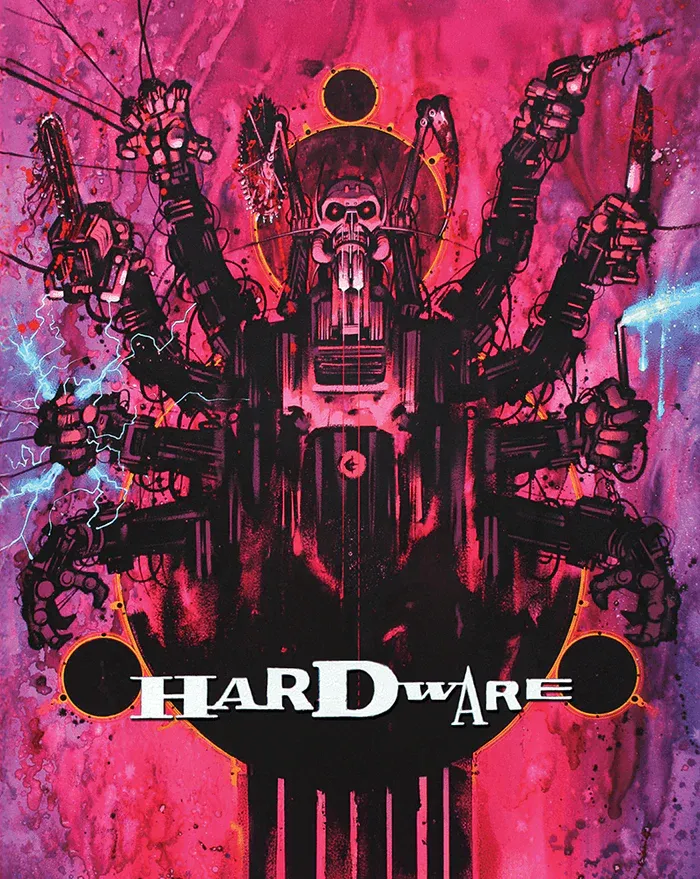Hardware is a multi-genre collision of post-apocalyptic Mad Max-esque action, Cronenbergian body horror, and Tetsuo: The Iron Man-style techno-fetishism, wrapped in a late 1980s/early 1990s cyberpunk aesthetic that was years ahead of its time and situated firmly within the fury of the mid-period VHS exploitation frenzy. It was a film that seemed destined for the VHS shelves, and that's where I first encountered it in the early 1990s—as a big box clamshell with the infamous MARK-13 android head emblazoned on the cover. Yet despite the more dated elements of the production, it has remained a cult classic, loved for its mesmerising, psychedelic screenscapes and its future-shock paranoia that seems presciently relevant in 2025.
The film opens with a blazing crimson colour palette, as a nomadic figure wanders through a desert and finds a robotic skull. He takes it into a ruined post-industrial futurist city hellscape, where it is sold to Dylan McDermott's character, Moe. Moe wants it for his artist girlfriend. However, it's not just a destroyed robot head—it's a MARK-13 killing machine. After it reassembles itself into a more mobile and corporeal form, it sets out on its mission: killing everyone it possibly can, whether through violent dismemberment, or by injecting them with some kind of LSD that both pacifies and makes them hallucinate, thoroughly (and enthusiastically) enjoying their own death in a kind of cosmic, psychedelic miasma.
I'm not really doing Hardware's plot justice, since the film is too smart, too original, and too cleverly designed for such a reductive capsule summary. Nevertheless, it is a hybrid action-horror-western-art film that draws from The Terminator, Blade Runner, Robocop, and the cyberpunk novels of William Gibson in sketching out a violent, paranoid future in which the government creates robotic weapons designed to cull the population. Richard Stanley wrote and directed Hardware, and it is not unreasonable to consider it the work of an auteur who suffered from crippling failure-to-launch syndrome. He should have been the next in the Cronenberg/Verhoeven lineage of smart, brutal sci-fi/horror practitioners, but after Hardware and Dust Devil, he was exiled from mainstream filmmaking by the mishandled The Island of Dr Moreau in 1996, and only resurfaced as a feature director in 2019 indescribably insane Color Out of Space.

In 1990, though, Stanley’s was such an innovative, original voice, and Hardware, despite its limitations, is a great lost (now found) classic of genre filmmaking, and a “what if?” example of where this kind of filmmaking might have gone across the 1990s. His mixture of heavily stylised visuals, non-narrative storytelling, bizarrely non-linear editing, and impeccable sense of colour and composition are unique amongst his VHS brethren. Hardware isn't VHS trash, but an artfully constructed and richly textured piece of auteur filmmaking, and I’m pleased that it is being re-evaluated.
The film’s final act has always fascinated me: particularly the “death by hallucinogen” sequence, in which Stanley abandons the action/horror genre’s fascination with physical destruction and instead depicts a slow, lingering, but euphorically psychedelic death—scored to swelling opera music, with spiralling editing and claustrophobic cross-cutting between the protagonist and the MARK-13 in full reconstructed form. It's unlike anything you can imagine seeing in something like The Terminator, which treads somewhat similar terrain but has no interest whatsoever in deviating into abstract, avant-garde filmmaking. For this sequence to exist in a piece of quasi-exploitation cinema is fascinating and unsettling.
Hardware also has an amazing soundtrack; prominently showcasing both Ministry’s Stigmata and Public Image Ltd.’s Order of Death—roughly ten years before it found a higher-profile position on The Blair Witch Project meta-soundtrack. The film boasts cameos from Iggy Pop and Lemmy: so naturally, Iggy Pop and Motörhead’s music make their way into the film, alongside a clanking, noisy industrial score. It’s a perfect accompaniment to the dirty, ugly visuals, and the sculpting sequence set to Stigmata is a brilliant example of the marriage between music and image.
The era of the boutique Blu-ray is firmly underway, and while the larger U.S. labels are certainly engaged in some genuinely revelatory restoration efforts, the domestic Australian industry is a major contributor to this renaissance of physical media, and Umbrella stands as a key player. Their fully uncut, 4K HDR remaster of Hardware is the best the film has ever looked, leapfrogging the 1080p Synapse release and offering the viewer stunning images that draw out the richness of Stanley’s colour compositions. The film takes on an almost Argento-esque accentuation of the primaries, with the interior scenes often bathed in waves of crimson light. During the infamous psychedelic death sequence, Umbrella’s restoration work truly shines as the kaleidoscopic colour palette leaps off the screen—Stanley’s design feeling more impactful than it has on any other available release.
The Umbrella set also includes a host of extras, both physical and digital. In keeping with their stunning restoration of Caligula from 2014, they present Hardware in a range of configurations, priced accordingly. The physical extras are high quality: including a hardback book covering the making of the film, a copy of the script, and the requisite art cards, posters, and so on. The digital extras, however, make this the definitive release of the film. Two commentary tracks and a director’s interview with Richard Stanley remind us of what an interesting and nuanced speaker he is—his comments on the film are revelatory and are complemented by a feature-length documentary covering every aspect of the film’s creation, promotion, and release. These kinds of extras make the restoration work of companies like Umbrella even more essential, as they provide a ‘film school in a box’ that should please technically minded genre fans. They also provide a rich cultural context in which the film was created—essential for understanding not only how the film was made, but why.
The core extras are supplemented by a range of additional materials that should please fans of the film. Richard Stanley’s early short films—which stylistically paved the way for Hardware—are present and they are not the same shorts that were included on the Subversive Cinema release of Dust Devil. I’m always excited to see this kind of archival material, and being able to experience the evolution of Stanley’s work as a filmmaker was a joy. The set is rounded out by deleted scenes, promotional materials, and a storyboard featurette, which ensure that the release is comprehensive and offers a lovingly curated history of Hardware.
Not everyone will like Hardware, and it has always been somewhat polarising. It’s definitely unpalatable in a lot of ways; it’s violent and disturbing, but in the typically contradictory nature of Richard Stanley’s work, it is also quiet and contemplative. It’s futuristic, but much of the technology is very much what a 1990 filmmaker might think future tech would be. It lurches into strange detours that pull it away from the “robot kills everyone” premise that made so many other genre films like this successful. It looks like it should be a low-budget VHS version of The Terminator, but it is far more thematically ambitious—capturing Stanley’s political obsessions and the darker, more fascistic themes of dystopian techno-fetishism found in something like Blade Runner.
It has always been a film that has fascinated me, and the new 4K by Umbrella is as good as it’s ever looked. I suspect it will remain the definitive way to experience all that the film has to offer.
Highly recommended.
Director: Richard Stanley
Cast: Carl McCoy, Iggy Pop, Dylan McDermott
Writers: Richard Stanley, with additional dialogue by Michael Fallon (based on the story "SHOK!" by Steve MacManus, Kevin O'Neill)
Producers: JoAnne Sellar, Paul Tijbits
Composer: Simon Boswell
Cinematographer: Steven Chivers
Editor: Derek Trigg
Hardware is available on physical media via Umbrella Entertainment.
Screening or Streaming Availability:

